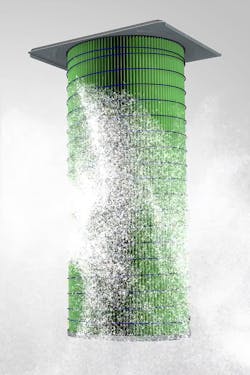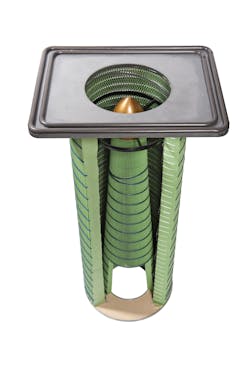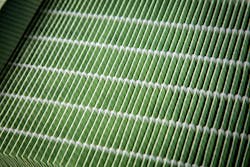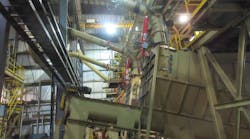Industrial dust collectors must continually remove large quantities of dust from a factory’s air. Unlike HVAC systems, dust collectors face very high dust loading. As a result, their filters can’t simply be replaced when they fill up like HVAC filters. They would need to be replaced every few days or even hours, depending on the application.
That is why most industrial dust collectors use filter cartridges instead of panel filters and are equipped with systems that self-clean the cartridges. These are called pulse-jet (or pulse) cleaning systems, and their effectiveness can differ widely among different types of collectors. A dust collector’s pulse-jet cleaning system can dramatically affect the system's effectiveness, energy usage and filter life.
What is pulse-jet cleaning?
Pulse-jet cleaning is critical to help dust collectors maintain a steady airflow (measured in cubic feet per minute [cfm]) and run at peak efficiency. This cleaning enables the filter cartridges to be continually loaded and unloaded with dust during operation so the collector can keep working with minimal disruptions.
Dust collectors typically contain multiple cylindrical filter cartridges, depending on the amount of air that has to be cleaned (see Figure 1). As a dust collector runs, dust loads onto the filters and forms a dust cake. This dust cake resists airflow across the filter media. The resistance is measured in inches water gauge or pascals and is referred to as pressure drop. The pressure drop across clean dust collector filters is usually less than one inch water gauge.
As dust loads and pressure drop increase, the filter efficiency increases, but the dust collector must work harder. This triggers the pulse-jet cleaning system, which knocks off the dust cake and starts the process over. As a result, the dust cake is constantly changing as are the pressure drop and filter efficiency. Eventually, the dust load will increase to a level at which pulse-jet cleaning is no longer helpful, and the only option is to change out the filter for a new one. However, this time can be extended many months if the dust collector is configured correctly and uses filters that can be effectively pulse cleaned.
How does pulse-jet cleaning work?
As previously mentioned, pulse-jet cleaning knocks the dust cake off the filter cartridges when air resistance (pressure drop) reaches a certain level. To knock off the dust, the pulse-jet cleaning system shoots a high-velocity pulse of compressed air into the center of the filter cartridge, countercurrent to the system airflow. The pulse of air expels the dust from the cartridge, and the expelled dust falls into a hopper at the bottom of the dust collector for disposal (see Figure 2). After each pulse of compressed air, airflow through the filters improves again.
To thoroughly clean the filters, the system should use clean, dry air compressed to between 90 and 100 psi. Lower pressures may not effectively clean the filters, and higher pressures may stress, tear or damage the filter media.
Pulse-jet cleaning can either be continuous or on demand. The operator can generally select either type, depending on the application. With continuous cleaning, the cleaning system turns on and off at regular, preset intervals. This is suited for porous dusts such as silica and other minerals, lightweight dusts such as fumed silica or paper fines, and high-dust-loading applications such as thermal spray or plasma cutting.
On-demand cleaning works well for most other dust types. With on-demand cleaning, the system monitors the pressure drop across the filters, activates the pulse-jet cleaning when the pressure drop reaches a preprogrammed high setpoint, and turns off the pulse-jet cleaning when the pressure drop reaches a preprogrammed low setpoint.
Using on-demand cleaning allows you to operate the dust collector in a very narrow pressure drop range. This uses less compressed air than continuous cleaning and optimizes filter cleaning efficiency and filter life. Note that the on-demand settings will need to be adjusted occasionally to compensate for a slow but continual rise in the “clean” pressure drop value as more and more dust particles become embedded in the filter media over the life of the filters.
Efficient pulse-jet cleaning can lower a dust collection system’s energy and maintenance costs, while overcleaning the filters can cause shorter filter life and higher energy costs due to overuse of compressed air. To ensure efficient cleaning, the system operation must be optimized to suit the dust type and the filter design.
Factors that affect pulse-jet cleaning effectiveness
The performance of a dust collector’s pulse-jet cleaning system is directly related to the type of filter cartridges used. Filter cartridge design, filter media type and pleating technology all affect how well the filter cartridges can be cleaned.
Filter cartridge design
As already discussed, most industrial dust collectors use cylindrical, cartridge-style filters to maximize the square footage of usable filter media.
Some premium-quality filter cartridges also have inner cones with additional pleated filter media to further expand the amount of usable media (see Figure 3). The pulsed air is evenly distributed along the outer pack of the filter and through the inner cone, ejecting more dust from the filters straight into the hopper.
High-efficiency filter cartridges generally cost more, but they can handle higher airflows while maintaining the required efficiency. The filters are cleaned more thoroughly with each pulse, so the airflow remains unrestricted and the pressure drop remains low for a longer period of time. This means you can replace them less often, making up for the higher purchase price.
Beware of inexpensive replacement filters, which can fail in a short amount of time, defeating the purpose. One reason is that they cannot withstand the power of the pulse-jet cleaning system. Malfunctioning filters create a mess by sending dust into the work area, which reduces air quality, causes a potential health risk for workers, contaminates products and can even damage equipment.
Filter media
Filter media is the “fabric” that is pleated and inserted into the cylindrical cartridges. The airstream is pulled through this media to capture airborne contaminants. The air continues through the media, while the particles remain on the filter media.
It is important to use a filter cartridge that contains the right media type for the application, dust type, operating temperature and level of moisture in the process. The correct media type will better release the dust during pulse-jet cleaning. The two categories of media commonly used are:
- Nonwoven cellulosic blend: This is the most economical choice for dry dust collection applications at operating temperatures up to 160°F (71°C).
- Synthetic polyester or polyester-silicon blend: This lightweight, washable media can handle dry applications with maximum operating temperatures ranging from 180°F (82°C) up to 265°F (129°C).
If required, filter media can also be treated with flame-retardant compounds, antistatic coatings, or nanofibers to prevent dust from penetrating deeply into the media.
Pleating technology
When the pleats of the filter media are tightly packed, the pulse-jet cleaning system will not eject the dust that has settled between the pleats. Tightly packed pleats also increase the air resistance through the filters and diminish airflow. With a wide-pleat filter, 100 percent of the media is usable, allowing the collected dust to release from the filter and keeping the resistance lower through the filter for a longer time (see Figure 4).
Some wide-pleat filters use synthetic bead pleat separators to ensure that the pleats remain wide and open for the best dust release possible (see Figure 5). These separators prevent the media from folding over on itself, which causes the filter to plug.
Note that a wide-pleat filter will often contain fewer square feet of media than a tightly pleated model. However, the total square footage of media is not as important as the total square footage of usable media. Filters that are fabricated with more usable media can move more air and process more dust.
Use ASHRAE Standard 199 to evaluate pulse-jet cleaning effectiveness
For the HVAC industry, minimum efficiency reporting value (MERV) ratings are king. Higher MERV ratings generally signify superior filtration. However, that is not always true for industrial dust filters, which operate in a dynamic environment and work as part of a dust collection system.
ASHRAE Standard 199 should be your first “go-to” when evaluating a dust collection system, including its pulse-jet cleaning effectiveness. This will ensure that you are maximizing air quality while minimizing energy usage and filter costs.
Jonathan Cooper is an aftermarket technical support and internal sales manager at Camfil Air Pollution Control (APC).
Camfil Air Pollution Control






